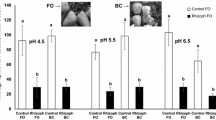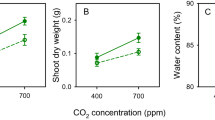Abstract
The role of saprophytic phyllosphere yeasts in removing aphid honeydew and other nutrients from wheat leaves was evaluated in growth cabinet experiments at different temperatures and relative humidities. Population densities of both pink and white yeasts (Sporobolomyces roseus and Cryptococcus laurentii, respectively) increased between 12 and 24°C, if nutrients were supplied. White yeast numbers increased rapidly at a constant vapor pressure deficit (VPD) of 0.10 kPa and alternating VPDs of 0.10 and 0.61 kPa (each 12 hours per day) but decreased at a constant VPD of 0.61 kPa. In growth cabinet experiments with aphids on wheat plants, the amount of aphid honeydew on the leaves was lower when yeast population densities were high. Addition of amino acids to leaves with honeydew had no effect on yeast population density or the rate of honeydew consumption. This indicated that low concentrations of amino acids in aphid honeydew are not a limiting factor for honeydew consumption by the yeasts. The naturally occurring saprophytes efficiently removed fructose, sucrose, and melezitose from the phyllosphere of field-grown wheat plants.
Similar content being viewed by others
References
Auclair JL (1963) Aphid feeding and nutrition. Annu Rev Entomol 8:439–490.
Bashi E, Fokkema NJ (1977) Environmental factors limiting growth of Sporobolomyces roseus, an antagonist of Cochliobolus sativus, on wheat leaves. Trans Br Mycol Soc 68:17–25.
Dickinson CH (1973) Effects of ethirimol and zineb on phylloplane microflora of barley. Trans Br Mycol Soc 60:423–431.
Dickinson CH, Wallace B (1976) Effects of late application of foliar fungicides on activity of microorganisms on winter wheat flag leaves. Trans Br Mycol Soc 76:103–112.
Dik AJ, Fokkema NJ, Van Pelt JA (1991) Consumption of aphid honeydew, a wheat yield reducing factor, by phyllosphere yeasts under field conditions. Neth J PI Path 97:209–232.
Fokkema NJ, Riphagen I, Poot R, De Jong C (1983) Aphid honeydew, a potential stimulant of Cochliobolus sativus and Septoria nodorum and the competitive role of saprophytic mycoflora. Trans Br Mycol Soc 81:355–363.
Hewitt BR (1958) Spectrophotometric determination of total carbohydrate. Nature 182:246–247.
Phaff HJ (1970) Sporobolomyces roseus. In: Lodder J (ed) The yeasts. North-Holland, Amsterdam, pp 850–854.
Phaff HJ, Fell JW (1970) Cryptococcus laurentii. In: Lodder J (ed) The yeasts. North-Holland, Amsterdam, pp 1120–1125.
Rossing WAH, Van de Wiel LAJM (1990) Simulation of damage in winter wheat caused by the grain aphid Sitobion avenae. I. Quantification of the effects of honeydew on gas exchange of leaves and aphid populations of different size on crop growth. Neth J Pl Path 96:343–364.
Zadoks JC, Chang TT, Konzak CF (1974) A decimal code for the growth stages of cereals. Weed Res 14:415–421.
Author information
Authors and Affiliations
Rights and permissions
About this article
Cite this article
Dik, A.J., Fokkema, N.J. & van Pelt, J.A. Influence of climatic and nutritional factors on yeast population dynamics in the phyllosphere of wheat. Microb Ecol 23, 41–52 (1992). https://doi.org/10.1007/BF00165906
Received:
Revised:
Issue Date:
DOI: https://doi.org/10.1007/BF00165906




